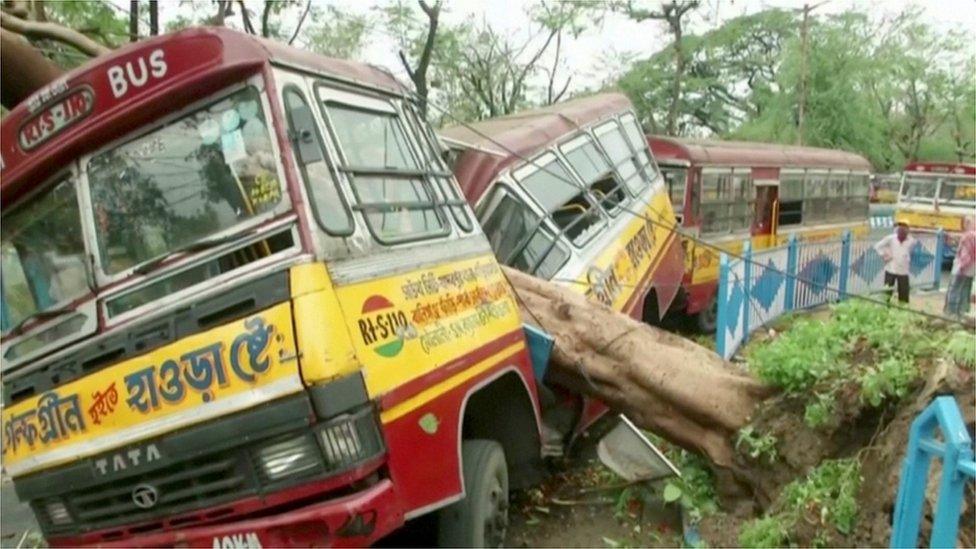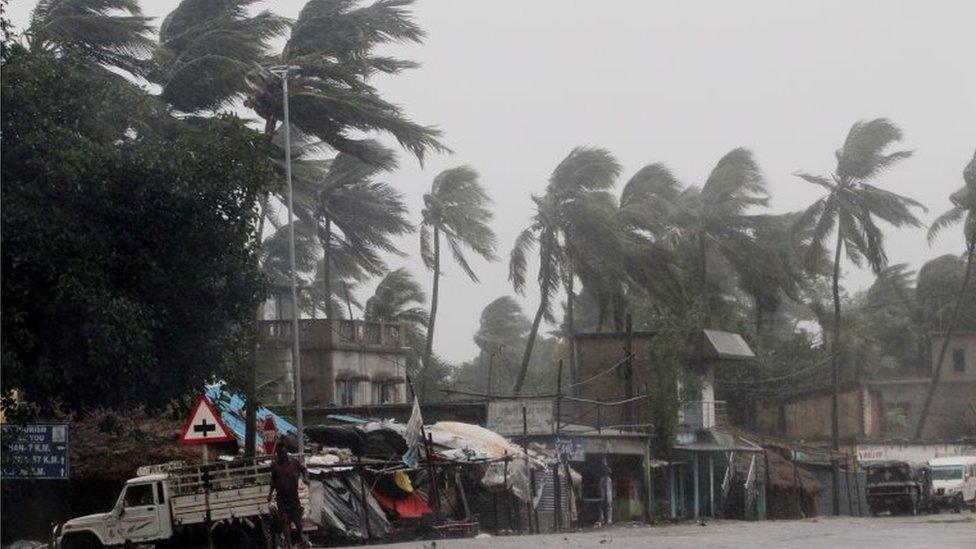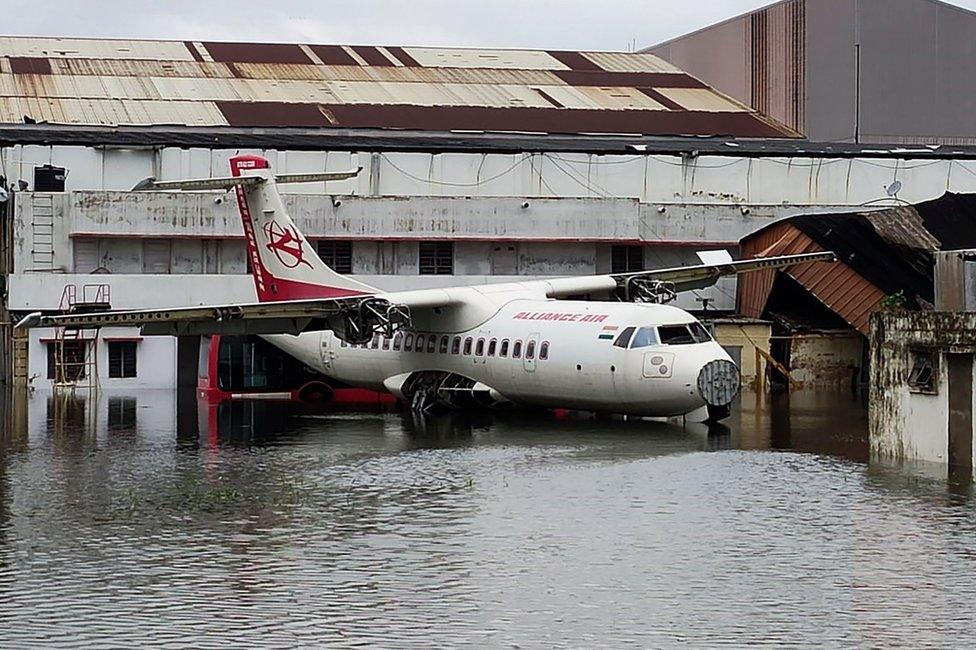Amphan: Kolkata devastated as cyclone kills scores in India and Bangladesh
- Published
Cyclone Amphan causes havoc in India and Bangladesh
The eastern Indian city of Kolkata has been devastated by a powerful cyclone which has killed at least 84 people across India and Bangladesh.
Amphan made landfall on Wednesday, lashing coastal areas with ferocious wind and rain. The storm is weakening as it moves north into Bhutan.
Thousands of trees were uprooted in the gales, electricity and telephone lines brought down and houses flattened.
Many of Kolkata's roads are flooded and its 14 million people without power.

Most of those who died were hit by falling trees or debris
The storm is the first super cyclone to form in the Bay of Bengal since 1999. Though its winds had weakened by the time it struck, it was still classified as a very severe cyclone.
Coronavirus restrictions have been hindering emergency and relief efforts. Covid-19 and social-distancing measures made mass evacuations more difficult, with shelters unable to be used to full capacity.
What's the latest on the cyclone?
Amphan began hitting the Sundarbans, a mangrove area around the India-Bangladesh border home to four million people on Wednesday afternoon, before carving north and north-eastwards towards Kolkata, a historic city that was the capital of the British Raj and widely known as Calcutta.
Parts of West Bengal and Orissa (also known as Odisha) states in India, and areas in south-west Bangladesh, bore the brunt, with winds gusting up to 185km/h (115mph).
At least 72 people have died in India's West Bengal state, and 12 deaths have been confirmed in Bangladesh.
West Bengal chief minister Mamata Banerjee said the devastation in Kolkata, the state capital, was "a bigger disaster than Covid-19".
"Area after area has been ruined," Ms Banerjee was quoted as saying by the Press Trust of India news agency. "I have experienced a war-like situation today."
Three districts in West Bengal - South and North 24 Parganas and East Midnapore - were very badly hit.
In Bangladesh, there are reports of tens of thousands of homes damaged or destroyed and many villages submerged by storm surges in low-lying coastal areas like Khulna and Satkhira. The authorities evacuated nearly 2.5 million people ahead of the cyclone.
Initial assessments of the damage are being hampered by blocked roads and flooding in all these areas.


A tale of two disasters
By Shamik Bag, Kolkata
On one of Kolkata's oldest streets, Rabindra Sarani, special prayers are being offered at the Kumartuli Sai Baba temple. Nobody died yesterday, a local says. A giant banyan tree has fallen, bringing down a small Shiva temple with it. While human casualties in have been low, the uprooted tree and temple are a reminder that gods or prayers couldn't halt the riotous run of the fierce Cyclone Amphan.
The conjunction of the two disasters - Covid-19 and Cyclone Amphan - and the challenging recovery effort facing administrators is highlighted by a narrow lane at a crossing point in the city. Its entrance is blocked as it's a Covid hotspot and containment zone but it is also immersed in flood waters which came with the cyclone.
Near the gates of the esteemed Presidency College, I spy the unique sight of a small catfish being preyed upon by a street dog. The catfish must have come with the floods but couldn't make it back home when the waters receded. The fish still has life and its sharp flailing about manages to keep the dog curious and a little intimidated too.

Images shared on social media showed electricity transformers exploding in busy neighbourhoods as the storm swept the city.
Allow X content?
This article contains content provided by X. We ask for your permission before anything is loaded, as they may be using cookies and other technologies. You may want to read X’s cookie policy, external and privacy policy, external before accepting. To view this content choose ‘accept and continue’.

"Thank God, we are safe," said one resident, who shared footage of tiled roofs being peeled off by the force of the wind and blown away.

Wind gusting up to 185km/h (115mph) bent palm trees on the Orissa coast
Local news networks showed uprooted traffic lights in flooded streets, as well as river jetties torn apart and vehicles crushed under fallen trees.
Allow X content?
This article contains content provided by X. We ask for your permission before anything is loaded, as they may be using cookies and other technologies. You may want to read X’s cookie policy, external and privacy policy, external before accepting. To view this content choose ‘accept and continue’.

Cyclone Amphan batters India and Bangladesh
Kajal Basu, who lives on the 12th floor of a high-rise building in the city, wrote on Facebook after the storm began: "It is like the vault of hell outside."
The apartment building seemed to be "swaying from side to side, mimicking an earthquake", he said.

Parts of Kolkata airport are submerged after the storm
Most people were at home when the storm struck. Kolkata and the rest of India is in lockdown because of the coronavirus pandemic.
What's the latest from Bangladesh?
Officials in Bangladesh feared Amphan would be the deadliest storm since Cyclone Sidr which killed about 3,500 people in 2007. Most died as a result of sea water surging in.
India's weather department had predicted storm surges as high as 10-16 feet (3-5 metres) from Amphan. The rising of sea levels in this way can send deadly walls of water barrelling far inland, devastating communities.
The total level of devastation in Bangladesh remains to be assessed but it's clear that there has been widespread destruction in areas that were in the path of the storm. In the city of Khulna, north of the Sundarbans, at least 83,000 homes were either destroyed or damaged, the Dhaka Tribune reports., external
Fewer people appear to have been killed than in India but the government fears about $1.5bn worth of damages, the newspaper says.
- Attribution
- Published19 May 2020

- Published19 May 2020
- Published4 May 2019
